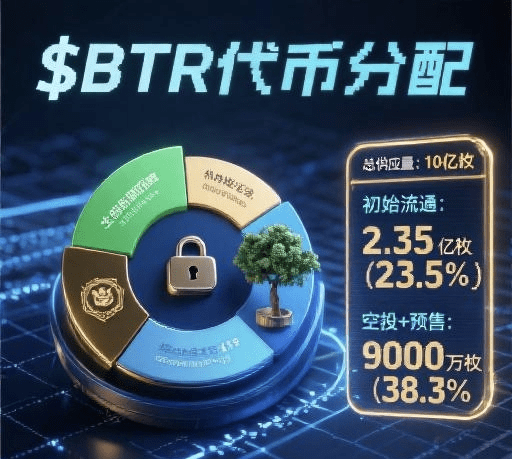The following is a comprehensive analysis of Bitlayer ($BTR) token economics based on the latest information, integrating the project white paper, market announcements, and ecological dynamics:
I. Token Basic Data
1. Total supply and initial circulation
Total supply: Fixed at 1 billion $BTR.
Initial circulation: 235 million released after TGE (23.5% of total).
Airdrop and pre-sale allocation: 90 million of the initial circulation is used for community airdrops and pre-sale activities (accounting for 38.3% of circulation).
2. Token Distribution Structure
Ecological incentives (highest proportion): 30% (300 million), for liquidity mining, user rewards, etc.
Institutional and private placement investment: 26% (260 million), total financing amount of 26 million USD.
Team and advisors: 15% (150 million), typically have a lock-up period.
Foundation reserves: 19% (190 million), for long-term ecological construction.
Exchange liquidity: 10% (100 million), ensuring market trading depth.

II. Tiered Pricing Structure and Release Mechanism
$BTR adopts a tiered pricing strategy, reflecting the project party's expectations for value-added:
Binance Pre-TGE $0.02/unit early platform users (requires Alpha points)
CoinList public offering $0.2/unit Public investors (ended)
Official website "Treasure Chest" event $0.3/unit Community participation (highest cost layer)
Release rhythm: Institutional and team shares typically have a lock-up period of 6-24 months, avoiding short-term selling pressure.
III. Ecological Incentive Mechanism Design
1. Binance Booster Program
Allocate 30 million $BTR (3% of total), phased airdrop.
The first phase distributes 5.7 million tokens to users holding ≥61 Binance Alpha Points, aiming to enhance DeFi participation.
Historical data shows that similar activities (e.g., Arbitrum) have previously driven short-term TVL growth of over 30%.
2. Tasks and NFT rewards
Users can earn 5200 $BTR through verification tasks (including 1200 early + 4000 new).
Purchasing specific NFTs (e.g., "Bitlayer Lucky Helmet") can earn an additional 2000, activated after binding an Alpha account.
3. BTC Yield Income Products
Users staking BTC to generate YBTC (wrapped Bitcoin) can earn up to 20% APR by depositing into the strategy pool.
Yield composition: 5%-8% BTC quantitative yield + 5% $BTR rewards + 7% DSN tokens.
New user first deposit reward of 10 $BTR (limited), directly incentivizing ecological cold start.
IV. Institutional Cooperation and Ecological Integration
Sui cross-chain bridging: Introduces Bitcoin liquidity into the Sui ecosystem through BitVM Bridge, allowing YBTC holders to participate in staking and lending, expanding $BTR use cases.
Institutional entry: Collaborating with Bitcoin ETF issuers (such as Franklin Templeton) to promote BTCFi compliance and attract traditional funds.
Technical endorsement: Based on BitVM's ZK verification solution, addressing Bitcoin scalability issues and providing a secure underlying for the ecosystem.

V. Potential Risks and Controversies
1. Token centralized release risk: In Q3-Q4 2025, 90 million airdropped tokens will be unlocked, which may trigger selling pressure.
2. Pricing tier dispute: Pre-TGE ($0.02) and public offering ($0.2) price difference reaches 10 times, the community questions the profit space for early investors.
3. Technical dependence: The ecological development heavily relies on the progress of BitVM implementation; delays will affect the expansion of DeFi applications.
Conclusion: Model characteristics and market positioning
$BTR token economics binds early participants with tiered pricing, captures liquidity with high incentives, and expands utility through cross-chain integration, aiming to transition the Bitcoin ecosystem from 'market dreams' to 'price-earnings ratio'. Short-term focus on the release rhythm of airdrops after TGE, long-term needs to verify the implementation of BitVM technology and the scale of institutional funding entry. Investors should assess the real value support of tokens in conjunction with ecological progress (such as TVL growth, protocol integration).
#Bitlayer @BitlayerLabs $BTR